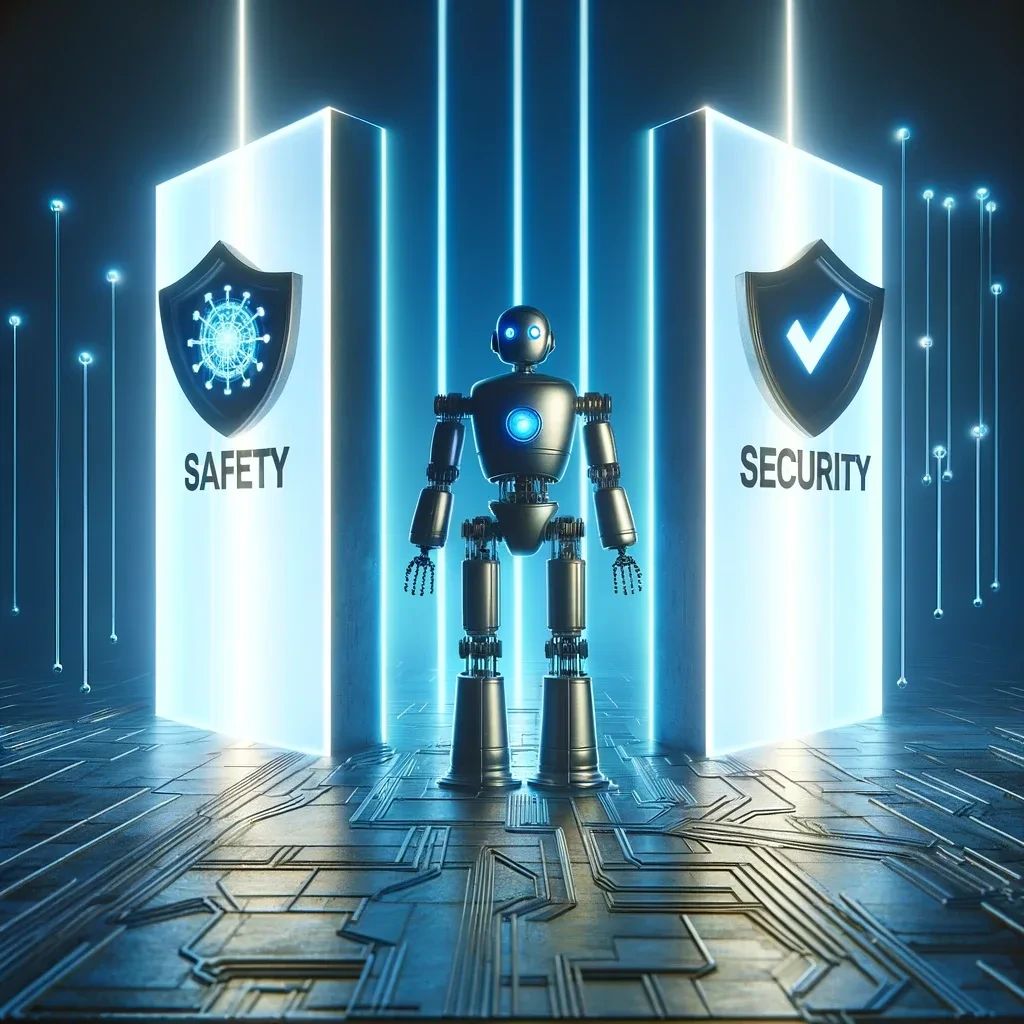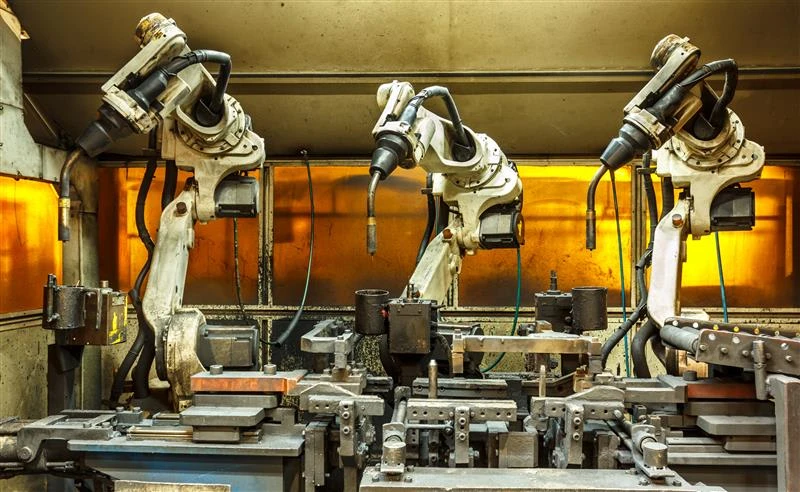Robotics: Fundamentals, Safety, and Security
Hello my friends and welcome to my space where I chat about all the cool stuff shaping our tomorrows. This past year has been a deep dive into the whirlwind of tech advancements for me. But, there's this one area that keeps pulling me back in. ROBOTICS!!! Diving into Cybersecurity has really tuned my radar to the finer points of technology. Robotics is an area where I see boundless progress, yet discussions on its safety and security seem to be in the shadows.
Now, maybe it's my unabashed fascination with all things space and space systems that's coloring my perspective, but let's face it, we're making giant leaps as a civilization. From dreams of revisiting the Moon and setting up lunar bases to the audacious plans of launching astronauts to Mars, the role of robots and autonomous systems in building the infrastructure before astronauts land on these celestial bodies is undeniable.

Yes, this sounds like Sci-Fi, but as we deploy these robotic systems to new frontiers, we have to take into account the safety and security that these technologies offer when interacting with humans. Will they potentially cause harm to our astronauts from malfunctions or are they secure from the reach of hackers or Nation State Actors which in turn can be a safety risk to our astronauts? These are things we have to as a people pay close attention to. Whether we're here on Earth or out in space, this tech touches all of us in some way.
To really tackle these issues head-on, we need to start with a solid grasp of the nuts and bolts of these technologies. Doing so allows us to start building a knowledge base for critical thought on such issues.
I’m excited to be your guide on this adventure, introducing you to a world brimming with new ideas and thoughts.
Now,
Let’s dive in!
The Three Pillars of Robotics
If we want to start at the fundamentals of robotics, let’s break down the essential three pillars: sensors & actuators, computation units, and communication. Here's a quick explanation of what keeps these mechanical wonders ticking.

Sensors and Actuators: The Perceptive and Dynamic Forces of Robots
Imagine giving robots a way to sense the world and react. This is where sensors and actuators come into play. Sensors are the eyes and ears of robots, giving them information on their surroundings. They can pick up everything from light to sound, guiding robots to make smart moves. Actuators are the muscle, bringing digital decisions to life. Whether it’s moving around or manipulating objects, actuators are where the actions and movement start.
For example, imagine a drone flying through a forest. Its sensors are on constant alert, spotting any obstacles to avoid, while actuators ensure it moves smoothly, adjusting its path on the fly. This interconnectedness lets robots handle tasks with finesse and reliability. Similarly, a robotic arm on an assembly line relies on flawless coordination between sensors and actuators to handle objects gently and with precision.
Computational Units: The Intellectual Epicenter of Robots
At the core of every robot is its computational unit, essentially the brain where all the logic happens. This brain takes in data from sensors, crunches it, and sends out orders to actuators. It's a constant loop of sensing, processing, and acting that allows robots to engage with their environment in meaningful ways.
The real game-changer is when these brains start learning from past experiences, thanks to machine learning. If you are interested in learning about this topic, check my article below for an introduction to machine learning.
This learning method not only betters their performance but also opens the door to innovations and discoveries we’ve yet to imagine.
Communication Systems: The Channels of Interaction and Understanding
Now, onto how robots communicate. Their communication systems are the vital links ensuring parts of a robot, or even a swarm of robots, work harmoniously. Whether through wired or wireless means, these systems are critical for transmitting data, commands, and feedback. For tasks that have several aspects for being complex, like coordinating a team of drones for a rescue operation, communication can make or break the mission.
In space or the busy floors of a warehouse, the strength of these communication links are very important. They ensure data flows smoothly, commands reach their destinations, and everyone’s on the same page. As we move forward into an era of more autonomous robots, their ability to communicate effectively will be crucial in realizing the full potential of robotics in every sphere of life.
And there you have it! The three pillars of robotics. It’s the blend of these elements that breathes life into machines, allowing them to do everything from assembling products with precision to coordinating with humans in space.

Communication and Coordination in Robotics
From what was explained, we now understand that seamless communication and coordination are the backbone of any robotic system. It's what makes these entities perform with such grace and precision. This harmony is achieved through something called the ROS (ROBOTIC OPERATING SYSTEM) computational graph, which is a sophisticated network that ensures that every sensor, actuator, and computational unit plays its part.
ROS Master
At the heart of robotic communication stands the ROS master. It's responsible for making sure each node (component) knows where to send and receive its bits of information. This is important in operations that demand precision and timely execution. However, the ROS master does more than just coordinate. It ensures the robotic system communicates in sync with every component.
Yet, with great communication comes great responsibility, especially regarding security. Protecting the ROS master from unauthorized access is important. A breach here could lead to misinformation or taking control of the entire system. Securing this central hub of communication is absolutely important.
Topics and Messages: The Linguistic Framework of Robotics
In the field of robotics, 'topics' and 'messages' form the basic language that allows for clear and precise communication. Topics act as dedicated channels for specific kinds of data or commands, while messages are the actual information sent through these channels. This system ensures that every instruction and piece of data is transmitted clearly and accurately.
Imagine that you see a robotic assistant in a factory, receiving detailed messages about what parts to assemble. These messages are similar to the script it follows to ensure each product is assembled perfectly. This precision in communication is what allows robots to perform such complex tasks flawlessly.
However, this precision also makes these messages a prime target for cyber threats. An intercepted or tampered message could lead to incorrect operations, posing risks of damage or disruption. Therefore, securing these communication lines, and ensuring every message is safely encrypted and authenticated, is important in maintaining the integrity of robotic operations.
Data Layer Graph
At the base of all these operations lies the data layer graph, a detailed map of all the connections within a robotic system. It's similar to the wiring behind a machine's panel, outlining how data flows from one component to another.
This graph is dynamic, constantly guiding the flow of information to ensure that every part of the robot gets the data it needs to function correctly. For example, in an autonomous vehicle, it's what ensures sensory data is promptly sent to the brain of the car for processing, which in turn sends the right commands to navigate safely. The data layer graph, however, introduces its own set of vulnerabilities. A flaw in this network can lead to serious breaches or malfunctions. A deep understanding and constant attention to this network of connections are fundamental for the safety and security of robotic systems.

Robotics' Safety and Security Nexus
We find ourselves at the crossroads of safety and security, two pillars critical to the trust and reliability we place in these automated wonders. It's a realm where ensuring that robots are both harmless and protected from harm becomes most important.
Safety: The Commitment to Harmlessness
At the forefront of robotics safety is the unwavering commitment to ensuring these marvels do not inadvertently become agents of harm. This encompasses designing robots with layers of fail-safes, arming them with a clear awareness of their surroundings, and programming them with the flexibility to adapt and avoid potentially dangerous situations.
Take, for example, the realm of healthcare, where a robotic assistant must maneuver through bustling hospital corridors, interact gently with patients, and provide support to medical staff all without causing the slightest disruption or harm. Achieving this level of operational safety requires sophisticated sensory and computational capabilities but also a stringent adherence to safety protocols.

But safety in robotics goes beyond just preventing accidents. It's about promoting a deep-seated trust among users that these machines will perform their tasks reliably and safely, be it in industrial settings, as delivery drones, or as companions assisting the elderly. Building this trust is as much about technical excellence as it is about transparency, communication, and ethical considerations.
Security: The Shield Against Harm
As the interconnectedness and autonomy of robots increase, so too does their exposure to potential cyber threats. Protecting robotic systems from unauthorized access, safeguarding the integrity of their data, and making sure that they operate under strict command control are all aspects of robotics security.

Consider the scenario of defense, where an autonomous drone's security against hacking is not just desirable but crucial. Such protection requires not only the implementation of advanced encryption and authentication measures but also constant attention against emerging threats. This point really hits home the importance of having solid security measures in place. It's a big deal and something we can't afford to overlook.
Keeping our robots safe also means keeping a tight lid on the data they collect and process.. In a world where data's pretty much gold, making sure this info stays confidential, intact, and accessible when we need it is key. We're talking a full-on security game plan here; from tech safeguards, solid policies, and an understanding of security practices from start to finish in our robot deployments.
Understanding and Mitigating Robotics' Vulnerabilities and Threats
As robotics become more deeply embedded in our lives and take on multiple tasks, they face an increasing variety of vulnerabilities and threats. Acknowledging and addressing these challenges is the first step toward building secure and resilient robotic systems.
Deciphering the Vulnerabilities
Every system, robotics included, comes with its own set of vulnerabilities. These can pop up from various places such as a slip in the design, software glitches, or maybe even a loophole in how it communicates to the world. And yep, you guessed it! These are open invitations for the hackers to sneak in, snatch up sensitive info, or throw a wrench into the whole operation.
So, what's the game plan to keep our robotic pals safe and sound? Well, it's all about staying on your toes and being ready to spring into action. We're talking deep-dive security checks, playing the role of a cyber intruder (penetration testing) to find vulnerabilities, and always having our ears to the ground for the latest in security news and updates. It's not a one-and-done deal. It's more like a never-ending mission to keep our robotic systems in tip-top shape and secure from any possible security breaches.
Recognizing the Threats
The array of threats facing robotic systems is as varied as the systems themselves. From malware and hacking attempts to physical tampering and insider threats, the landscape of potential dangers is broad and constantly evolving.
Identifying these threats involves not just understanding the technical aspects but also the operational context in which these robotic systems function. It's about anticipating the intentions and capabilities of potential adversaries and designing the system to be resilient against such threats.

Resilience and Readiness
Building a resilient robotic system goes beyond addressing vulnerabilities and threats. It's about developing a tough capability to detect, contain, and recover from security incidents. This means designing systems that can identify potential breaches, mitigate their impact, and quickly return to normal operations following an incident. Achieving this resilience requires a holistic approach that combines technical solutions with comprehensive policies, training programs, and a culture of security that extends across the entire robotic ecosystem. It should be a collaborative effort to ensure that the potential of robotics can be realized safely and securely.
The world of robotics is brimming with possibilities. Think about it: we're talking about turbocharging how industries work or even setting foot on distant planets. But let's be real, it's not all smooth sailing. Getting a grip on the nuts and bolts of robotics, making sure our robotic companions talk and work together seamlessly, keeping them safe from harm, and staying one step ahead of any vulnerabilities or threats is the real deal.
By rolling up our sleeves and facing these challenges head-on, we're setting the stage for a robotics revolution. We just don’t need robots that are great at their job, but also who are guardians of their own fort, keeping everything safe, sound, and running smoothly. The horizon for robotics is promising, and with a bit of careful planning and care, we're on track to make sure it's not just a bright future, but a secure one for all of us to share.
Thank you for staying to the end. Stay tuned for deeper dives into this topic!
Like this project
Posted Feb 12, 2024
Learn the fundamentals of robotics, safety, and security. How secure are our robotic systems against threats?
Likes
0
Views
19





